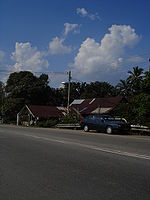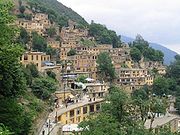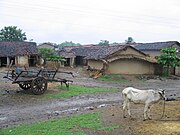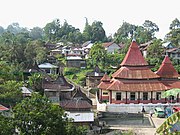Village
From Wikipedia, the free encyclopedia
A village is a clustered human settlement or community, larger than a hamlet, but smaller than a town or city[1]. Though generally located in rural areas, the term urban village may be applied to certain urban neighbourhoods, such as the West Village in Manhattan, New York City and the Saifi Village in Beirut, Lebanon. Villages are normally permanent, with fixed dwellings; however, transient villages[2] can occur. Further, the dwellings of a village are fairly close to one another, as against being scattered broadly over the landscape (‘dispersed settlement’).
Villages have been the usual form of community for societies that practice subsistence agriculture, and even for some non-agricultural societies. Towns and cities were few, and were home to only a small proportion of the population. The Industrial Revolution caused many villages to grow into towns and cities; this trend of urbanisation has continued, though not always in connection with industrialisation. Villages have thus been eclipsed in importance, as units of human society and settlement.
Traditional villages
Although many patterns of village life have existed, the typical village was small, consisting of perhaps 5 to 30 families. Homes were situated together for sociability and defense, and land surrounding the living quarters was farmed.
South Asia
India
"The soul of India lives in its villages", declared M. K. Gandhi [3] at the beginning of 20th century. According to the 2001 Indian census, 74% of Indians live in 638,365 different villages.[4] The size of these villages varies considerably. 236,004 Indian villages have a population less than 500, while 3,976 villages have a population of 10,000+. Most villages have their own temple, mosque or church depending on the local religious following.
East Asia
Taiwan
In Taiwan, villages are divisions under president. The village is called a GRAM/GAON (村) under a rural township (鄉) and a li (里) under an urban township (鎮) or a county-controlled city.
East Asia
Taiwan
In Taiwan, villages are divisions under president. The village is called a GRAM/GAON (村) under a rural township (鄉) and a li (里) under an urban township (鎮) or a county-controlled city.
Southeast Asia
Brunei, Indonesia and Malaysia

A kampung in the Malaysian state of Johor.
The term kampung in the English language has been defined specifically as "a Malay hamlet or village in a Malay-speaking country" [5] In other words, a kampung is defined today as a village in Brunei, Indonesia or Malaysia. In Malaysia, a kampung is determined as a locality with 10,000 or fewer people. Since historical times, every Malay village came under the leadership of a penghulu (village chief), who has the power to hear civil matters in his village (see Courts of Malaysia for more details). A Malay village typically contains a "masjid" (mosque) or "surau" (Muslim chapel), stilt houses and paddy fields. Malay and Indonesian villagers practice the culture of helping one another as a community, which is better known as "joint bearing of burdens" (gotong royong)[6], as well as being family-oriented (especially the concept of respecting one's family [particularly the parents and elders]), courtesy and believing in God ("Tuhan") as paramount to everything else. It is common to see a cemetery near the mosque, as all Muslims in the Malay or Indonesian village want to be prayed for, and to receive Allah's blessings in the afterlife.
Philippines
In urban areas of the Philippines, the term "village" most commonly refers to private subdivisions, especially gated communities. These villages emerged in the mid-twentieth century and were initially the domain of elite urban dwellers. However, they are now common in Metro Manila and other major cities in the country and their residents can have a wide range of income levels. They may or may not correspond to administrative units (usually barangays) and/or be privately administered. Some examples of well-known villages in Metro Manila are Forbes Park and Dasmariñas Village.
Vietnam
Village, or "làng", is a basis of Vietnam society. Vietnam's village is the typical symbol of Asian agricultural production. Vietnam's village typically contains: a village gate, "lũy tre" (bamboo hedges), "đình làng" (communal house) where "thành hoàng" (tutelary god) is worshiped, "đồng lúa" (rice field), "chùa" (temple) and houses of all families in the village. All the people in Vietnam's villages usually have a blood relationship. They are farmers who grow rice and have the same traditional handicraft. Vietnam's villages have an important role in society (Vietnamese saying: "Custom rules the law" -"Phép vua thua lệ làng" [literally: the king's law yields to village customs]). Everyone in Vietnam wants to be buried in their village when they die
Central and Eastern Europe
Slavic countries
Selo (Cyrillic: село; Polish: wieś) is a Slavic word meaning "village" in Bosnia and Herzegovina, Bulgaria, Croatia, Macedonia, Russia, Serbia, and Ukraine. For example there are numerous sela called Novo Selo in Bulgaria, Croatia, and others in Serbia, and Republic of Macedonia. In Slovenia, the word selo is archaic; the common Slovene word for village is vas.
Bulgaria
In Bulgaria the different types of Sela vary from a small selo of 5 to 30 families to one of several thousand people. In Bulgaria it is becoming popular to visit villages for the atmosphere, culture, crafts, hospitality of the people and the surrounding nature. This is called the "selski tourism" (Bulgarian:селски туризъм meaning village tourism) .
Russia

Typical house in a
Russian village (derevnya)
In Russia, the bulk of the rural population are concentrated in villages. In Russian, two terms are mainly used to refer to these rural localities: selo (село) or derevnya (деревня). Historically, the formal indication of status was religious: a city (gorod) would have a cathedral, a selo would have a church, while a derevnya would have neither.
The lowest administrative unit of the Russian Empire, volost, or its Soviet or modern Russian successor, selsoviet, would usually be headquartered in a selo and embrace a few neighboring villages.
Between 1926 and 1989, Russia's rural population shrank from 76 million people to 39 million, due to urbanization, collectivization, dekulakisation and the World War II losses, but has nearly stabilized since.[citation needed] Mass starvation in Russia and other parts of the Soviet Union lead to the death of at least 14.5 million of peasants in the period 1930–1937 (including 5-7 million in the Holodomor). [7]
Most Russian villages have populations of less than 200 people, and it is the smaller villages which take the brunt of depopulation: e.g., in 1959, about one half of Russia's rural population lived in villages of fewer than 500 people, while now less than one third does. In the 1960s–1970s, the depopulation of the smaller villages was driven by the central planners' drive to get the farm workers out of smaller, "prospect-less" hamlets and into the collective or state farm's main village, with more amenities.[8]
Most Russian rural residents are involved in agricultural work, and it is very common for villagers to produce their own food. As prosperous urbanites purchase village houses for their second homes, Russian villages sometimes are transformed into dacha settlements, used mostly for seasonal residence.
The historically Cossack regions of Southern Russia and parts of Ukraine, with their fertile soil and absence of serfdom, had a rather different pattern of settlement from central and northern Russia. As opposed to the peasants of central Russia living in a village around the lord's manor, a Cossack family would often live on a farm of their own, called khutor. The word stanitsa (Russian: стани́ца; Ukrainian: станиця, stanytsia) would be used to refer to an administrative unit including a central village as well as a number of such khutors. Such a stanitsa village, often with a few thousand residents, would usually be larger than a selo in central Russia.
The term aul/aal is used to refer mostly Muslim-populated villages in Caucasus and Idel-Ural, without regard to the number of residents.
Western & Southern Europe
United Kingdom
A village in the UK is a compact settlement of houses, smaller in size than a town, and generally based on agriculture or, in some areas, mining or quarrying.
The major factors in the type of settlement pattern found are location of water sources, the organization of agriculture and landholding and the likelihood of flooding. For example, in areas such as the Lincolnshire Wolds the villages are often found along the spring line halfway down the hillsides, and with the original open field systems around the village. In northern Scotland, most villages are planned to a grid pattern located on or close to major roads, whereas in areas such as the Forest of Arden, woodland clearances produced small hamlets around village greens.
Some villages have disappeared (for example, deserted medieval villages), sometimes leaving behind a church or manor house and sometimes nothing but bumps in the fields. Clearances may have been to accommodate sheep or game estates, or they may have resulted from depopulation, such as after the Black Death or following a move of the inhabitants to more prosperous districts. Others have grown and merged and often form hubs within the general mass of suburbia - Charlton, London or Hampstead in London and in some cases outgrew a nearby town, such as Birmingham which outgrew Aston to become a major city. Many are now predominantly dormitory locations and have suffered the loss of shops, churches and other facilities.
Conceptually, from an English point of view, the village represents an ideal of England. Seen as being far from the bustle of modern life, it is quiet, harmonious, if a little inward-looking. This concept of an unspoilt Arcadia is present in many popular representations of the village such as The Archers or the best kept village competitions.
Many villages in South Yorkshire, North Nottinghamshire, North East Derbyshire and Northumberland are known as pit villages to denote their origins, as many of these villages such as Murton, County Durham only existed as hamlets before the sinking of a colliery in the early 20th centuary forced a rapid expansion of the population of these settlements and the colliery owners built new housing, shops, pubs and even churches for this new population. Some of these villages became so large they out grew nearby towns, both in terms of land area and population; a good example of this is Rossington in South Yorkshire which became over four times larger (in terms of population) than the nearby town of Bawtry; and some pit villages became so large, they actually became towns themselves, Such as Maltby in South Yorkshire whose population rose from 500 in the 19th centuary to over 75,000 in 2007.
Villages tend to occur in lowland England where they partly replaced the more scattered pattern of single farms and hamlets in the mid-Saxon period. In the UK the main historical distinction between a hamlet and a village is that the latter will have a church, and will therefore usually have been the worship centre of an ecclesiastical parish. However, it should be noted that some civil parishes may contain more than one village. The typical village used to have a pub and shops as well as a blacksmith. However, many of these facilities are now gone and many villages are dormitories for commuters. The population of such a settlement could range from a few hundred people to around five thousand. A village is distinguished from a town in that:
- A village should not have a regular agricultural market, although today such markets are uncommon even in settlements which clearly are towns.
- A village does not have a town hall nor a mayor.
- There should also be a clear green belt or open fields surrounding its parish borders.
France
Same general definition as in England, see, for example, Saint-Benoît-du-Sault.
Netherlands
In the flood prone districts of the Netherlands, villages were traditionally built on low man-made hills called terps before the introduction of regional dyke-systems.
Ireland
Villages in Ireland would traditionally consist of a church, a pub, a shop and a post office. Some also contain facilities such as schools and health centres.
The Middle East
Lebanon
Like France, villages in Lebanon are usually located in remote mountainous areas. The majority of villages in Lebanon retain their Aramaic names or are derivative of the Aramaic names, and this is because Aramaic was still in use in Mount Lebanon up to the 18th century.[9]
Many of the Lebanese villages are a part of districts, these districts are known as "kadaa" which includes the districts of Baabda (Baabda), Aley (Aley), Matn (Jdeideh), Keserwan (Jounieh), Chouf (Beiteddine), Jbeil (Byblos), Tripoli (Tripoli), Zgharta (Zgharta / Ehden), Bsharri (Bsharri), Batroun (Batroun), Koura (Amioun), Miniyeh-Danniyeh (Minyeh / Sir Ed-Danniyeh), Zahle (Zahle), Rashaya (Rashaya), Western Beqaa (Jebjennine / Saghbine), Sidon (Sidon), Jezzine (Jezzine), Tyre (Tyre), Nabatiyeh (Nabatiyeh), Marjeyoun (Marjeyoun), Hasbaya (Hasbaya), Bint Jbeil (Bint Jbeil), Baalbek (Baalbek), and Hermel (Hermel).
The district of Danniyeh conists of thirty six small villages, which includes Almrah, Kfirchlan, Kfirhbab, Hakel al Azimah, Siir, Bakhoun, Miryata, Assoun, Sfiiri, Kharnoub, Katteen, Kfirhabou, Zghartegrein, Ein Qibil.
Danniyeh (known also as Addinniyeh, Al Dinniyeh, Al Danniyeh, Arabic: سير الضنية) is a region located in Miniyeh-Danniyeh District in the North Governorate of Lebanon. The region lies east of Tripoli, extends north as far as Akkar District, south to Bsharri District and Zgharta District and as far east as Baalbek and Hermel. Dinniyeh has an excellent ecological environment filled with woodlands, orchards and groves. Several villages are located in this mountainous area, the largest town being Sir Al Dinniyeh.
An example of a typical mountainous Lebanese village in Dannieh would be Hakel al Azimah which is a small village that belongs to the district of Danniyeh, situated between Bakhoun and Assoun's boundaries. It is in the centre of the valleys that lie between the Arbeen Mountains and the Khanzouh.
Sub-Saharan Africa
Australasia & Oceania
Pacific Islands Communities on pacific islands were historically called villages by English speakers who traveled and settled in the area. Some communities such as several Villages of Guam continue to be called villages despite having large populations that can exceed 40,000 residents.
New Zealand
The traditional Maori village was the pa, a fortified hill-top settlement. Tree-fern logs and flax were the main building materials.
Australia The term village often is used in reference to small planned communities such as retirement communities, shopping districts, and tourist areas. Small rural communities are usually known as towns regardless of how small they are.
South America
Argentina
Usually set in remote mountainous areas, some also cater to winter sports and/or tourism, see: Uspallata, La Cumbrecita, Villa Traful and La Cumbre
North America
United States
-
Incorporated villages
- See also: Administrative divisions of New York#Village and Village (Oregon)
In twenty[10] U.S. states, the term "village" refers to a specific form of incorporated municipal government, similar to a city but with less authority and geographic scope. However, this is a generality; in many states, there are villages that are an order of magnitude larger than the smallest cities in the state. The distinction is not necessarily based on population, but on the relative powers granted to the different types of municipalities and correspondingly, different obligations to provide specific services to residents.
In some states such as New York, Wisconsin, or Michigan, a village is an incorporated municipality, usually, but not always, within a single town or civil township. Residents pay taxes to the village and town or township and may vote in elections for both as well. In some cases, the village may be coterminous with the town or township. There are also many villages which span the boundaries of more than one town or township, and some villages may even straddle county borders.
There is no limit to the population of a village in New York; Hempstead, the largest village in the state, has 55,000 residents, making it more populous than some of the state's cities. However, villages in the state may not exceed five square miles (13 km²) in area.
In the state of Wisconsin a village is always legally separate from the township(s) that it has been incorporated from. The largest village is Menomonee Falls, which has over 32,000 residents.
Michigan and Illinois also have no set population limit for villages and there are many villages that are larger than cities in those states.
Villages in Ohio are almost always legally separate from any townships that they may have been incorporated from (there are exceptions, such as Chagrin Falls, where the township includes the entirety of the village). They have no area limitations, but must reincorporate as cities if they grow to over 5,000 in population. Villages have the same home-rule rights as cities with fewer of the responsibilities. Unlike cities, they have the option of being either a "statutory village" and running their governments according to state law (with a six-member council serving four-year terms and a mayor who votes only to break ties) or being a "charter village" and writing a charter to run their government as they see fit.
[citations needed]
In Maryland, a locality designated "Village of ..." may be either an incorporated town or a special tax district.[11] An example of the latter is the Village of Friendship Heights.
In states that have New England towns, a "village" is a center of population or trade, including the town center, in an otherwise sparsely-developed town or city — for instance, the village of Hyannis in the city of the Town of Barnstable. Although over the years the village has become more like a small town within a town with it now being the center of everything for Barnstable.
Unincorporated villages
In many states, the term "village" is used to refer to a relatively small unincorporated community, similar to a hamlet in New York state. This informal usage may be found even in states that have villages as an incorporated municipality, although such usage might be considered incorrect and confusing.
Footnotes
- ^ village: Definition and Much More from Answers.com
- ^ http://www.google.co.uk/search?hl=en&safe=off&q=%22transient+villages%22&btnG=Search&meta=
- ^ http://www.pibbng.kar.nic.in/feature1.pdf
- ^ http://www.censusindia.net/results/2001census_data_index.html
- ^ http://www.m-w.com/dictionary/kampung Meriam-Webster Online
- ^ Geertz, Clifford. "Local Knowledge: Fact and Law in Comparative Perspective", pp. 167-234 in Geertz Local Knowledge: Further Essays in Interpretive Anthropology, NY: Basic Books. 1983.
- ^ Robert Conquest (1986) The Harvest of Sorrow: Soviet Collectivization and the Terror-Famine. Oxford University Press. ISBN 0-19-505180-7.
- ^ "Российское село в демографическом измерении" (Rural Russia measured demographically) (Russian). This article reports the following census statistics:
| Census year | 1959 | 1970 | 1979 | 1989 | 2002 |
| Total number of rural localities in Russia | 294,059 | 216,845 | 177,047 | 152,922 | 155,289 |
| Of them, with population 1 to 10 persons | 41,493 | 25,895 | 23,855 | 30,170 | 47,089 |
| Of them, with population 11 to 200 persons | 186,437 | 132,515 | 105,112 | 80,663 | 68,807 |
- ^ A project proposal
- ^ Village
- ^ 2002 Census of Governments, Individual State Descriptions (PDF)
External links
Village types:























